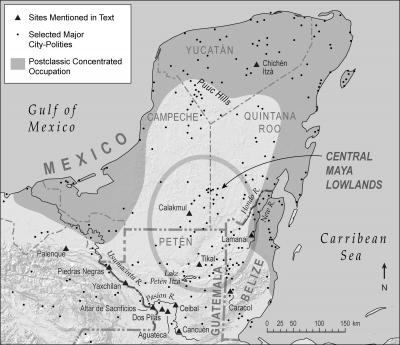Why Did the Mayan Civilization Collapse? A New Study Points to Deforestation and Climate Change
A severe drought, exacerbated by widespread logging, appears to have triggered the mysterious Mayan demise
![]()

Bustling Mayan cities such as Tikal, in present-day Guatemala, were likely abandoned due to a combination of deforestation and drought. Photo via Wikimedia Commons/Shark
It’s long been one of ancient history’s most intriguing mysteries: Why did the Maya, a remarkably sophisticated civilization made up of more than 19 million people, suddenly collapse sometime during the 8th or 9th centuries? Although the Mayan people never entirely disappeared—their descendants still live across Central America—dozens of core urban areas in the lowlands of the Yucatan peninsula, such as Tikal, went from bustling cities to abandoned ruins over the course of roughly a hundred years.
Scholars and laypeople have proposed countless theories accounting for the collapse, ranging from the plausible (overhunting, foreign invasion, peasant revolt) to the absurd (alien invasion, supernatural forces). In his 2005 book Collapse, though, Jared Diamond put forth a different sort of theory—that a prolonged drought, exacerbated by ill-advised deforestation, forced Mayan populations to abandon their cities. That hypothesis has finally been put to the test with archaeological evidence and environmental data and the results published this week in a pair of studies.
In the first study, published Tuesday in the Proceedings of the National Academy of Sciences, researchers from Arizona State University analyzed archaeological data from across the Yucatan to reach a better understanding of the environmental conditions when the area was abandoned. Around this time, they found, severe reductions in rainfall were coupled with an rapid rate of deforestation, as the Mayans burned and chopped down more and more forest to clear land for agriculture. Interestingly, they also required massive amounts of wood to fuel the fires that cooked the lime plaster for their elaborate constructions—experts estimate it would have taken 20 trees to produce a single square meter of cityscape.

The central Yucatan lowland, site of most major Mayan cities, was abandoned due to the stresses of deforestation and drought. Image via Barbara Trapido-Lurie/Arizona State University
The other study, published by researchers from Columbia University and elsewhere this week in Geophysical Research Letters, applied quantitative data to these trends. Using population records and measurements from current forested and cleared lands in the region, they constructed a computer model of deforestation in the Yucatan and ran simulations to see how this would have affected rainfall.
Because cleared land absorbs less solar radiation, less water evaporates from its surface, making clouds and rainfall more scarce. As a result, the rapid deforestation exacerbated an already severe drought—in the simulation, deforestation reduced precipitation by five to 15 percent and was responsible for 60 percent of the total drying that occurred over the course of a century as the Mayan civilization collapsed. The lack of forest cover also contributed to erosion and soil depletion.
In a time of unprecedented population density, this combination of factors was likely catastrophic. Crops failed, especially because the droughts occurred disproportionately during the summer growing season. Coincidentally, trade shifted from overland routes, which crossed the heart of the lowland, to sea-based voyages, moving around the perimeter of the peninsula.
Since the traditional elite relied largely upon this trade—along with annual crop surpluses—to build wealth, they were sapped of much of their power. This forced peasants and craftsmen into making a critical choice, perhaps necessary to escape starvation: abandoning the lowlands. The results are the ornate ruins that stretch across the peninsula today.
The collapse is especially intriguing because it seemingly occurred at “a time in which developed a sophisticated understanding of their environment, built and sustained intensive production and water systems and withstood at least two long-term episodes of aridity,” says B.L. Turner, the lead author of the ASU study. In other words, the Maya were no fools. They knew their environment and how to survive within it—and still they continued deforesting at a rapid pace, until the local environment was unable to sustain their society.
One of the lessons of these complementary studies, says climate modeler Robert Oglesby of the University of Nebraska, who worked on the second paper, is that our reshaping of the environment can often have unintended consequences—and we may not have any idea of what they are until it’s too late. For a present-day example, we can even look to another region where the ancient Maya lived, Guatemala, which is undergoing rapid deforestation. “There’s a tremendous amount of change going on in Guatemala,” said Oglesby. “They may be that much more vulnerable to a severe drought.”
/https://tf-cmsv2-smithsonianmag-media.s3.amazonaws.com/accounts/headshot/joseph-stromberg-240.jpg)
/https://tf-cmsv2-smithsonianmag-media.s3.amazonaws.com/accounts/headshot/joseph-stromberg-240.jpg)